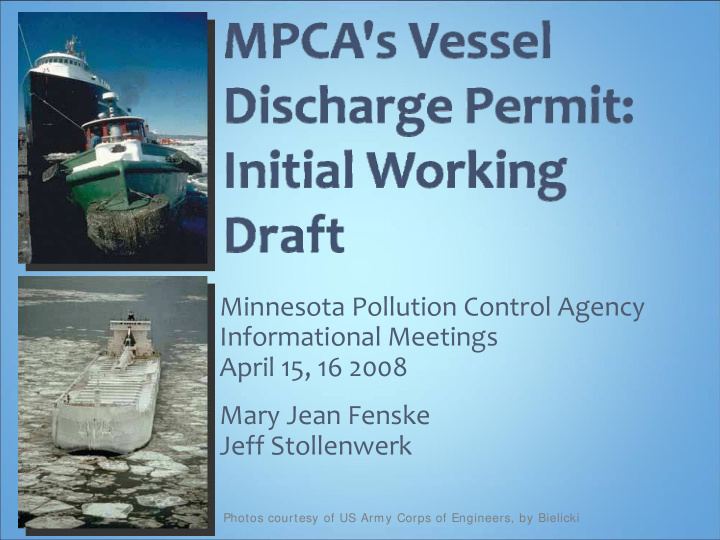



Minnesota Pollution Control Agency Informational Meetings April 15, 16 2008 Mary Jean Fenske Jeff Stollenwerk Photos courtesy of US Army Corps of Engineers, by Bielicki
� Alter existing aquatic ecosystems � Costly to deal with impacts Spiney water flea � Move from Lake Photo courtesy of US Fish and Wildlife Service Superior to inland lakes and rivers Zebra mussels Photo courtesy of Center for Great Lakes and 2 Aquatic Sciences
Vectors: Pathways Water Recreation Maritime Commerce Boating equipment Ballast Water Livewells Concept Map Hull/Anchor fouling Fishing equipment Bait Agency Activities Tourism Stocking/hatcheries Assessment Charter fishing Harbor maintenance Ecotours Navigation Float planes Homeland security Diving Research Organisms in Trade Canals and Diversions Pets/Aquariums Aquatic plants Locks Shoreline restoration Power canals Bait Compensating works Live food fish Diversions On-line sales Illegal Activities Commercial Fishing Plants Fishing equipment/vessels Fish stocking Bait On-line sales Fish Aquaculture 3
� US Coast Guard rulemaking � EPA general permit development � Proposed federal legislation � Proposed state legislation (MN, OH, IN, WI, IL, PA, NY) � State regulatory agency permitting (MI, MN, OH, NY, WI) 4
Federal exemption successfully challenged � 1973: EPA excluded vessel discharges from NPDES permitting � September 2006: U.S. District Court decision in CA eliminates the vessel discharge exemption effective September 30, 200. � EPA appealing decision � EPA developing a permitting strategy www.epa.gov/owow/invasive_species/ballast_water.html 5
� Encourage/support federal action on Great Lakes shipping � Participate in US EPA GP development � Comment on federal regulations/ bills � Work with USCG � Communication and coordination � Develop state regulatory program for vessel discharges – rulemaking and permit 6
Limited rulemaking � Modify Minn. R. 7001.1030, subp. 2A to remove exemption of vessels from NPDES permitting (a state exemption) � Published Request for Comment in March (preliminary notice) � Publish Notice of Intent to Adopt rules in May/June (formal proposal) � Goal: rule changes effective by Sept. 30, 2008 7
Early March Initial stakeholder input meetings MPCA begins drafting initial Mid-March permit/ application Stakeholder input meetings initial April draft permit - April 15 in St. Paul & April 16 in Duluth June Start 30-day public notice September Final permits issued 8
Rulemaking Permit � Public comment period for � Requesting input on Request for Comment ends working draft language by April 23, 2008 April 30, 2008 � Can provide input after this � Can provide input after this date date � Formal 30 day public � Formal 30 day public comment period starts comment period starts when publish Notice of when publish proposed Intent to Adopt Rules General Permit (June) (May/June) Posting written input/ comments received at: 9 http://www.pca.state.mn.us/programs/ballastwater.html
� Strong concurrence that invasive species are a serious problem � Federal regulation is the preferred mode � Frustration about the lack of meaningful regulation at the federal level over past 2 decades 10
� Concern about a state-by-state patchwork of regulations � More stringent MN regulation than elsewhere could: � send MN shipping business elsewhere � cause economic harm to MN industries dependent on MN ports Need to see permit language for further discussion 11
Protect waters through a water quality permit that: 1. prevents ship-mediated spread of aquatic invasive species 2. is supportive of a viable shipping industry 12
� Act immediately where possible � Protect MN waters through ballast water discharge standards � Regulatory consistency � Coordination with other regulators 13
MPCA issues permit MPCA issues permit • • Vessels comply with BMP Vessels comply with BMP • • Submit ballast/ sediment management plan Submit ballast/ sediment management plan Submit treatment technology plan Submit treatment technology plan • • Begin monitoring Begin monitoring • • Comply with biological standards Comply with biological standards Vessels install technology Vessels install technology (dependent on dry dock availability) (dependent on dry dock availability) Sept March Sept Sept 2008 2009 2009 2013 14
� Ballast water oceangoing and lakes-only vessels transiting Minnesota waters of Lake Superior and its harbors � > 50 meters in length � > 8 cubic meters ballast capacity � Exclusions � US armed forces vessels � Vessels with sealed tanks � On-shore ballast water treatment not covered Photo courtesy of US Army Corps of Engineers, photo by Jerry Bielicki 15
Discharge standards do not apply in emergency situations – to save human lives or to save a vessel 16
� Sensitive areas – � DNR-designated scientific and natural areas � far NE end of MN near Hat Point Non-suspended sediment (tank cleaning) 17
� Technology Based � Best Management Practices � IMO D-2 Standards � Water Quality Based � Reviewing studies and research Photo courtesy of Minnesota Extension � Specific to treatment technology Service, Don Breneman � Residual oxidants � Dissolved oxygen 18
� Includes requirements based on 33 CFR 151.2035 � Avoid uptake of discharge in areas/ at times that are more likely to have problems � Sediment management – No discharge in MN waters � Discharge minimal ballast water essential for vessel operations � Create and maintain ballast/sediment management plan and train personnel in its use � Oceangoing ships must conduct saltwater exchange 19
� Beginning 1 year � Biological monitoring � Items to be resolved � Sampling port design / installation � Sampling protocol � Analytical protocol Photo courtesy of Michigan Sea Grant 20
� Discharge Monitoring Report required Frequency yet to be determined � Ballast Water and Sediment Management Plan to be available � Inspection and entry Allows reasonable compliance evaluation activities 21
� Immediately Best Management Practices � 180 days Ballast Water / Sediment Management Plan � Beginning 1 year � Biological monitoring � Plans & Installation schedule to meet discharge standards � End of permit term (2013) Compliance with discharge standards 22
� Applicability � Discharge standards � Implementation schedule � Monitoring and reporting � Other 23
Jeff Stollenwerk, Supervisor 218-723-4957 jeff.stollenwerk@pca.state.mn.us Mary Jean Fenske, Vessel Discharge Program Coordinator 651-297-5472 maryjean.fenske@state.mn.us 24
Recommend
More recommend